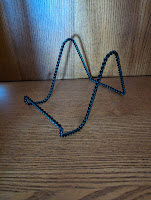Simple glue, fabric or napkins & a 4" x 4" porcelain tile, some sealant and you can have some of the cutest places to set a hot pot on.
 |
Please see my coaster tutorial for directions here: mod podge coasters tutorial
The only difference in the making of these is that I don't back the entire surface with peal and stick cork. I usually just glue a little felt on the back so I don't worry about scratching things and call it good. They are already quite sturdy and don't need any extra bulk.
Otherwise, the steps done on a trivet is identical to the coaster tutorial. 4"x4" is just the right size for a lot of the larger napkins and for having a nice tile on the counter to protect it from heat.
I love doing seasonal tiles for my own home and keep them on the stove top between uses to give it a little bit of a touch of my style.
Since plain white ceramic tiles can be bought from most hardware stores for around $5 for a pack of 9 (one square foot)... they can be a really affordable way to get into the crafting basics.Could you make money???
I really think so - while mod podge allows for great creations and allows you to get a quality result with little effort - more and more crafters are learning about how easy it is and not everyone will be ready to pay for it. But trivets tend to draw more attention and their size makes them a little easier for selling to customers.
For the trivets I have made, I have only spent about $5 for nine tiles, plus around $.50 to $.75 for a napkin (though material, and self-printed items are definitely other options). In 20 minutes (and a month + several days) drying/curing time - I can easily make 9 tiles. I'm sure you could probably make more or make sets of coasters at the same time..
You could save money buy buying things in bulk - the glue, the sponge brushes, the tiles, etc. I do prefer ceramic tiles over wood, because if you are going to be putting hot pans on them, it's nice to know they aren't going to slide around.
Giving yourself a base rate of $15/hour and buying in bulk, you could easily make 9 tiles under $1.50 each. Even if you were to sell them for $5-$10 each, you'd easily make a profit.
Creativity is really your best bet for finding buyers.
Depending upon how many you make, you can buy seasonal or holiday napkins in a stack for a few bucks but then you will typically end up with about enough napkins to make 40 trivets. Instead, I prefer to buy napkins from resellers on Facebook or through their website so I only have to buy one or two napkins per style. Since they often run sales after the holiday is over, I can often get a couple of napkins for under a $1 and have enough to make 4-8 trivets.









